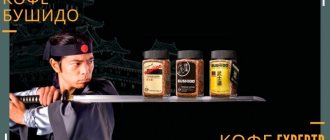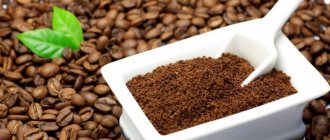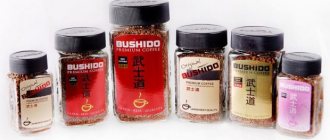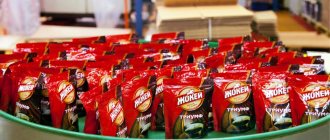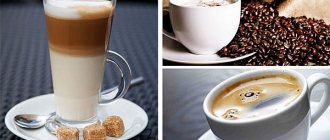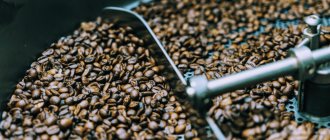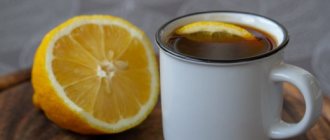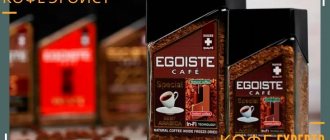Bushido brand
In an attempt to connect East with West, Bushido coffee was born. But this is not a product from Japan, as is commonly believed. The idea came to employees of the Russian company Horse. As a result, a concept was developed to create a trademark based on the Land of the Rising Sun. The products were supposed to combine the conservatism, quality, and originality of the East with the modernity of the West.
The result was a line of products that met the stated requirements. There are relatively few varieties, but they differ from each other in their special zest and uniqueness. The manufacturer is Switzerland, where the secret of manufacturing the finished product is carefully hidden; only a few facts are known that indicate the uniqueness of the product. One of the lines is produced in Italy, the other in the Netherlands.
Bushido is modern coffee in convenient packaging with hieroglyphs on the label. There are natural grains, ground products and freeze-dried options, similar in taste to a drink brewed in a Turk. There are also gold products made under the influence of wood smoke.
Egoist coffee, which is another trademark of the Horse coffee house, is considered to be an analogue of the brand’s products.
Natural Bushido coffee
The list of grain products is small. There is also ground coffee, ready for preparation in a Turk or coffee machine. Some varieties are rarely found on supermarket shelves, so you will have to order the product through an online store to try it. It also happens that products are discontinued.
Varieties of natural Bushido coffee:
- Bushido Red Katana - premium grain and ground in bags of 227 g or 1000 g. Consists of 100% Specialty Arabica grown in Ethiopia and Latin America. The aroma is represented by notes of red berries, sweetness, and a peach tint. The raw materials are collected by hand, washed, and dried under the sun in the mountains. One of the most common types of roasting is urban. Store products are produced in the Netherlands.
- Bushido Specialty is a similar option to the previous one. The only difference is in the composition – 100% Arabica Premium.
- Bushido Sensei – ground and beans, produced in bags of 227 g. Washed Arabica, hand-picked, high-mountain sun-dried, medium roast. The variety from the Netherlands is considered the most refined of the entire line; it has a coffee, delicate, sweet, floral, apricot aroma. Composition: 100% Premium Arabica, grown in East Africa or Central America.
- Bushido Forte – ground and bean coffee in soft packaging. Produced in Kenya from a blend of premium Tanzanian and Kenyan Arabica beans. The beans are roasted using a unique technology over oak wood, which adds a faint aroma of tree bark to the finished drink. Also, the production method allows you to preserve coffee oil and beneficial substances in the raw materials. Thanks to slow heat treatment, the acidity of the product is low, the drink acquires a rich taste and dense creamy foam.
- Bushido Delicato - premium natural ground coffee in soft paper packaging of 250 g. Country of origin: Italy. A special feature of the production is the roasting of Arabica beans over orange wood. The taste is dense, with fruity notes, the aroma is floral, with a hint of jasmine.
- Bushido Intenso is premium natural Arabica coffee, packaged in paper bags of 250 g. Deep aroma, caramel taste with notes of ripe hazelnut. The peculiarity of the production is the roasting of beans on olive wood.
- Bushido Original - ground natural coffee in a 250 g tin. Rarely found on sale, possibly discontinued.
Bushido beans
True gourmets should definitely try Bushido coffee beans. It is also produced in two types: Original and Specialty. Raw materials - elite and noble Arabica of a certain harvest. During production, grains undergo 15-level sorting.
The taste, like the aroma, is very rich and intense. This bean coffee is produced in limited and small quantities. For 250 g of packaged grains you will need to pay from 500 to 700 rubles.
Types of Bushido instant coffee
Instant products are found on Russian markets much more often than their natural counterparts. Bushido instant coffee is produced in the form of a high-quality sublimate. The product is quite expensive among similar products; according to customer reviews, it differs in organoleptic characteristics and similarity to a drink made from coffee beans.
Common varieties on the market:
- Bushido Kodo – instant freeze-dried ground coffee – In-Fi technology. Buenaventura blend, produced in Switzerland from Arabica beans grown in Tanzania, South America, and Ethiopia. Produced in glass jars of 95 g. The production technology involves washed grains, hand picking, drying under the sun high in the mountains, and urban roasting. The drink has a sweet aftertaste and floral aroma.
- Bushido Original is freeze-dried coffee in glass jars of 50, 100 g or a bag of 75 g, produced in Switzerland from Arabica beans grown in Tanzania and South America. The Buenaventura blend is produced using washed beans, high-mountain sun drying, and freeze-dried technology. The taste is rich, the density is medium.
- Bushido Black Katana – freeze-dried coffee in glass jars of 50 g or 100 g from Switzerland using freeze-dried technology. Veracruz blend, made from Arabica beans grown in South and Central America. Product production involves washing the grains, hand picking, drying under the sun in the mountains, and French roasting. The taste of the finished drink is chocolate, rich, balanced.
- Bushido Red Katana – freeze-dried coffee from Switzerland in glass jars of 50 g or 100 g. Ingredients: Paranagua blend. Arabica is grown in East Africa. Original taste, strong wine aroma, long aftertaste.
- Bushido Light Katana is a sublimate from Switzerland using freeze-dried technology in glass jars of 50, 100 g. It contains a Kenyvaro mixture collected on the slopes of Kilimanjaro. The finished drink is characterized by a delicate fruity taste and slightly noticeable sourness. This is the weakest type of Bushido coffee and is distinguished by the fact that it is easy to drink even without sugar and milk.
- Bushido 24 Karat Gold – freeze-dried Swiss coffee in 100 g glass jars from a mixture of Kenyan Arabica varieties. Differs in the content of ultra-fine edible gold 24 carats. The additional component enhances the effect of antioxidants contained in the main raw materials, so the drink is credited with the ability to rejuvenate the body.
Coffee Bushido: reviews
You can find different reviews about Bushido coffee, but the lion's share of them are positive. This is not surprising. The excellent reputation of Bushido coffee is ensured by Swiss precision and scrupulousness in observing technologies for sorting, preparing and packaging coffee beans. This is one of the leading coffee production facilities.
The company's specialists are constantly searching for methods, recipes and techniques for mixing different varieties of Arabica. This allowed him to win a gold medal at a competition in Moscow in 2007. The activity of the Bushido company lies in its slogan - “The Path to Perfection” and reflects the history of the brand and the meaning of a creative approach to the production of the world's most popular drink. This is Bushido coffee. That's all, friends.
You can also read these posts:
- Colombian coffee - a drink from a distant South American country Good day, readers of our site! What do we know about a country like Colombia? Maybe,…
- We prepare Ivan tea - healthy and aromatic Ivan tea is one of the ancient drinks that was known in Rus'. He has...
- Ristretto coffee - true and aromatic Good day, site readers! What will help you cheer up in the early morning, when you don’t feel like it at all...
- Rooibos tea from distant South Africa Hello everyone, friends! In distant South Africa, a drink made from a plant of the legume family is very popular…
Which Bushido coffee should you choose?
There is no clear answer to the question. The entire line of Bushido brand products is of decent quality, for this reason you need to focus on general recommendations:
- Choose according to taste and aroma. Some are looking for a drink with a certain blend, flavor, aftertaste. To simplify the task, you can use the information provided above about the Bushido range.
- By strength, caffeine content. This is also not for everyone. Some prefer strong, rich coffee like Black Katana, while others prefer the delicate, fruity Light Katana. It is recommended to focus on your own feelings after drinking drinks, as well as your personal tolerance to caffeine.
- An important aspect is the price. Bushido is an expensive product, so the cost of the product may influence your choice. On the other hand, the more expensive the coffee, the better the quality. Products of different prices also have different organoleptic characteristics.
- You can also choose coffee according to the method of preparing the finished drink. No matter how Bushido manufacturers position their product, the instant product is still different from the natural one. And it’s not at all suitable for preparing a number of desserts and drinks.
- The country of origin can sometimes influence the choice. Although this is not particularly relevant for Bushido, since most of the products are produced in Switzerland, where all technological processes are carefully monitored. Another example is a line of goods from Italy, distinguished by a specific taste. In other productions they also try to adhere to the general concept of the company and monitor compliance with the technological process.
- The most important thing is to choose original Bushido coffee. Counterfeits are not much cheaper, but no one can guarantee their quality and safety, let alone the organoleptic properties of the prepared coffee.
Bushido Original Coffee
+++++++++ Good day everyone! +++++++++
Finally, my little hands got around to writing a review for this coffee.
++++++++++++++++++++++++++++++++++++++++++++++++++++++++++++++++++++++++++++
I love coffee, especially in the morning. Of course, nothing beats freshly ground and brewed coffee. But... apparently not made by me( There is a wonderful coffee machine, there is a hand mill (the grinding is exactly for this coffee machine), in the end there is a copper Turk, but... No matter what kind of coffee I try to make, it turns out outright rubbish( Perhaps not I take those varieties, or my hands are in the wrong place;) So for “brewed” coffee I had to buy a capsule coffee maker, but basically I have to be content with instant coffee.
+++++++++++++++++++++++++++++++++++++++++++++++++++++++++++++++++++++++++++++
I've been chasing Bushido for a long time (not because it's not on sale, but I caught a promotion at a discount, since it's not cheap, and it would be a shame if I bought it at full price, but didn't like it).
So, I caught the promotion and bought a jar. I don’t remember the exact price (it was before the New Year), but I remember that even with the promotion it cost me more than many others without a discount.
So, here it is - the treasured jar:
I don’t really understand why “the best Japanese quality” if Arabica coffee is made in Switzerland? Well, okay, high hopes were placed on it precisely because it was made in Switzerland. This for me was a guarantee of quality. Swiss cheese and chocolate immediately came to mind... For the same reason, it is clear why the price for it is an order of magnitude higher than for coffee packaged here:
The sides of the jar are also unusual; through the “coffee grain” you can see magical granules-crystals:
Cap with logo:
Opens, remove the protective foil:
As you can see, the coffee crystals are neat and of the same color. Not overcooked. No coffee dust.
Pour into a cup:
Fill with “hot, but not boiling water”:
Coffee is ready:
The appearance of the finished coffee and the aroma did not make much of an impression(
If I didn’t know what kind of coffee this was, I would have thought it was ordinary coffee in the mid-price category.
I usually add milk or cream to my coffee (I can’t have black). This time I decided to add ice cream. Build a view)))
Of course, it became more fun with ice cream, but...
********************************************************************************************
The coffee is generally good, but quite ordinary. Yes, there is no sour aftertaste, but at the same time it does not have “its own face.” This jar is long gone, but if someone treats me to something like this now, I won’t recognize him. He's kind of faceless.
I expected it to be as close in taste and aroma as cooked, but no(
I would be willing to buy coffee at full price if it was worth it. In this case it’s not worth it. I’d rather take the same Jacobs.
How much do Bushido products cost?
The price category of the products of this brand is quite high, which is explained by the quality and organoleptic characteristics of the product. Moreover, the cost varies depending on the dollar exchange rate, as well as on the specific region. Don’t forget about various promotions and discounts in stores, which will allow you to purchase quality products for fairly little money.
Table. Prices for Bushido coffee in rubles
| Name | 50 g | 95/100 g | 227 g | 250 g | 1000 g |
| Natural | |||||
| Red Katana | – | – | 280-350 | – | 1110-1300 |
| Specialty | – | – | 400-500 | – | – |
| Sensei | – | – | 300-400 | – | – |
| Forte | – | – | – | 400-510 | – |
| Delicato | – | – | – | 370-620 | – |
| Intenso | – | – | – | 330-510 | – |
| Sublimated | |||||
| Red Katana | 260-410 | 480-550 | – | – | – |
| Black Katana | 270-380 | 430-590 | – | – | – |
| Light Katana | 270-400 | 450-710 | – | – | – |
| Original | 310-450 | 650-700 | – | – | – |
| 24 Karat Gold | – | 1800-2100 | – | – | – |
| Kodo | – | 480-630 | – | – | – |
Bushido products are not cheap. A suspiciously low price should arouse mistrust, since the product may turn out to be counterfeit and, therefore, of low quality.
How to distinguish an original from a fake?
When buying coffee, it is important to focus on some points that can indicate the originality of the selected product. If necessary, you need to contact the seller with a request to show documentation for the products and carefully review the provided certificates.
How to distinguish between fake and original products:
- Real Bushido coffee has a three-dimensional logo in the form of a coffee bean shimmering from different angles.
- The original product must be packaged in a glass jar, paper or waterproof bag. Previously, you could find tin cans. Plastic packaging is a sign of counterfeit.
- It is recommended that you learn to read barcode information. The numbers hide information about the country of origin, company, product, as well as a control digit. All this needs to be compared with what is indicated on the label.
- The title must be spelled correctly. If at least one letter is changed, this is a clear sign of a fake.
- The low price should alert you.
